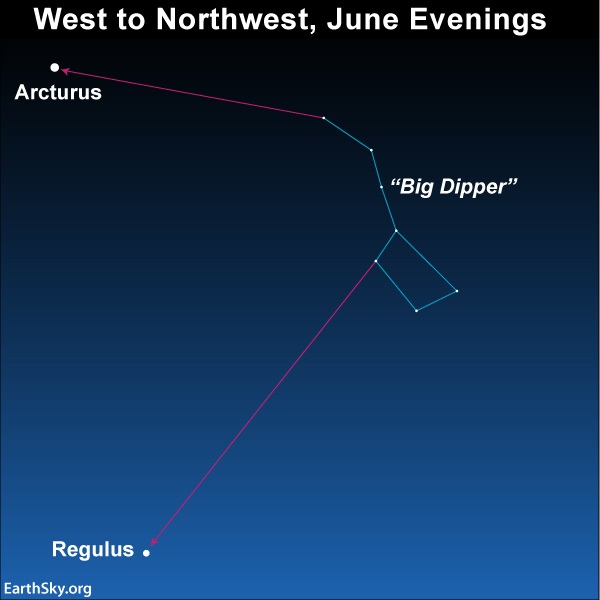
As darkness falls these next several evenings – May 28, 29, and 30, 2020 – watch the moon as it travels in front of the constellation Leo the Lion. When the moon first enters Leo, it’ll display a rather wide waxing crescent phase. When the moon finally leaves Leo a few days later, it’ll show a waxing gibbous phase. Midway though its trek in Leo, the moon will exhibit its half-illuminated first quarter phase.
By the way, the moon reaches its first quarter phase on May 30, at 3:30 UTC. At United States time zones, that means the first quarter moon comes on May 29, at 11:30 p.m EDT, 10:30 p.m. CDT, 9:30 p.m. MDT and 8:30 p.m. PDT.
On May 28 and 29, 2020, use the moon to find Regulus, the brightest star in the constellation Leo the Lion. This blue-white gem of a star is of 1st-magnitude brightness and is the 21st brightest star to light up the nighttime sky.
The moon is rather close to Regulus for only a few days each month. So when the moon is no longer there to guide you, let the Big Dipper serve as your handy guide to this star. The two bowl stars on the handle side of the Big Dipper faithfully point to Regulus.
Click on Heavens-Above Moon to find out the moon’s present phase and its present position on the zodiac.

Use the Big Dipper to locate the bright stars Arcturus and Regulus.
Regulus is a blue-white gem of a star, its color revealing that this star has a high surface temperature. Considering that Regulus is nearly 80 light-years away, it must be quite luminous (intrinsically bright) to shine at 1st-magnitude brightness in Earth’s sky. Regulus is several hundred times more luminous than our sun, and at Regulus’ distance, our sun would be not even be visible to the naked eye.
Normally, a star’s blue-white color indicates that the star is in the heyday of youth (only 50 to 100 million years old). But Regulus has a very close companion star which cannot be seen through the telescope but only detected with a spectroscope. It’s thought that Regulus’ companion could be a white dwarf star, in which case Regulus and its companion star would have to be at least a billion years old. Possibly, mass transfer of material from one star to the other in this close-knit binary star system acts as a fountain of youth, keeping Regulus young in its old age.
Regulus is the only 1st magnitude star to sit almost squarely on the ecliptic – the sun’s apparent yearly pathway in front of the constellations of the zodiac. Of course, the sun’s apparent motion in front of the stars is really a reflection of our planet Earth’s revolution around the sun.
Looking at the sky chart below, notice that Regulus dots a backwards question mark of stars, called “The Sickle.” The Sickle outlines the Lion’s head and mane, whereas the star Denebola (whose name means “tail of the lion” in Arabic) marks the Lion’s tail.

Chart of the constellation Leo via the IAU. The ecliptic depicts the annual pathway of the sun in front of the constellations of the zodiac. The sun passes in front of the constellation Leo each year from around August 10 to September 17, and has its yearly conjunction with the star Regulus on or near August 23.
Bottom line: These next several nights – May 28, 29 and 30, 2020 – use the moon to locate the constellation Leo and the star Regulus. Once the moon leaves the evening sky, starting around mid-June 2020, try to piece together the starlit figure of the Lion in a dark sky.
from EarthSky https://ift.tt/36AGDpc

As darkness falls these next several evenings – May 28, 29, and 30, 2020 – watch the moon as it travels in front of the constellation Leo the Lion. When the moon first enters Leo, it’ll display a rather wide waxing crescent phase. When the moon finally leaves Leo a few days later, it’ll show a waxing gibbous phase. Midway though its trek in Leo, the moon will exhibit its half-illuminated first quarter phase.
By the way, the moon reaches its first quarter phase on May 30, at 3:30 UTC. At United States time zones, that means the first quarter moon comes on May 29, at 11:30 p.m EDT, 10:30 p.m. CDT, 9:30 p.m. MDT and 8:30 p.m. PDT.
On May 28 and 29, 2020, use the moon to find Regulus, the brightest star in the constellation Leo the Lion. This blue-white gem of a star is of 1st-magnitude brightness and is the 21st brightest star to light up the nighttime sky.
The moon is rather close to Regulus for only a few days each month. So when the moon is no longer there to guide you, let the Big Dipper serve as your handy guide to this star. The two bowl stars on the handle side of the Big Dipper faithfully point to Regulus.
Click on Heavens-Above Moon to find out the moon’s present phase and its present position on the zodiac.

Use the Big Dipper to locate the bright stars Arcturus and Regulus.
Regulus is a blue-white gem of a star, its color revealing that this star has a high surface temperature. Considering that Regulus is nearly 80 light-years away, it must be quite luminous (intrinsically bright) to shine at 1st-magnitude brightness in Earth’s sky. Regulus is several hundred times more luminous than our sun, and at Regulus’ distance, our sun would be not even be visible to the naked eye.
Normally, a star’s blue-white color indicates that the star is in the heyday of youth (only 50 to 100 million years old). But Regulus has a very close companion star which cannot be seen through the telescope but only detected with a spectroscope. It’s thought that Regulus’ companion could be a white dwarf star, in which case Regulus and its companion star would have to be at least a billion years old. Possibly, mass transfer of material from one star to the other in this close-knit binary star system acts as a fountain of youth, keeping Regulus young in its old age.
Regulus is the only 1st magnitude star to sit almost squarely on the ecliptic – the sun’s apparent yearly pathway in front of the constellations of the zodiac. Of course, the sun’s apparent motion in front of the stars is really a reflection of our planet Earth’s revolution around the sun.
Looking at the sky chart below, notice that Regulus dots a backwards question mark of stars, called “The Sickle.” The Sickle outlines the Lion’s head and mane, whereas the star Denebola (whose name means “tail of the lion” in Arabic) marks the Lion’s tail.

Chart of the constellation Leo via the IAU. The ecliptic depicts the annual pathway of the sun in front of the constellations of the zodiac. The sun passes in front of the constellation Leo each year from around August 10 to September 17, and has its yearly conjunction with the star Regulus on or near August 23.
Bottom line: These next several nights – May 28, 29 and 30, 2020 – use the moon to locate the constellation Leo and the star Regulus. Once the moon leaves the evening sky, starting around mid-June 2020, try to piece together the starlit figure of the Lion in a dark sky.
from EarthSky https://ift.tt/36AGDpc

Aucun commentaire:
Enregistrer un commentaire